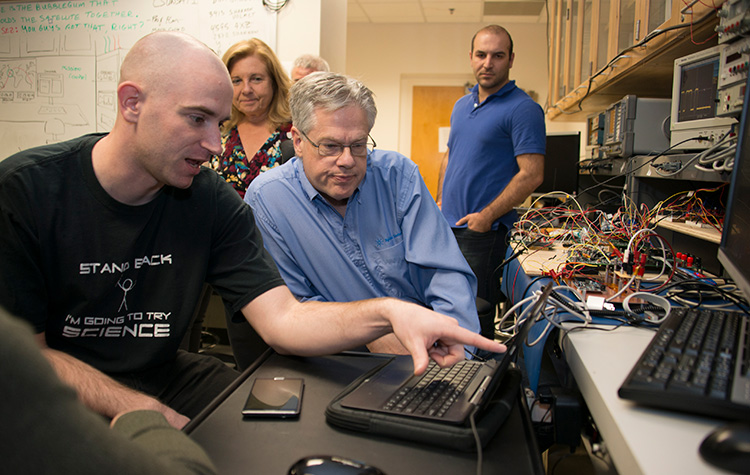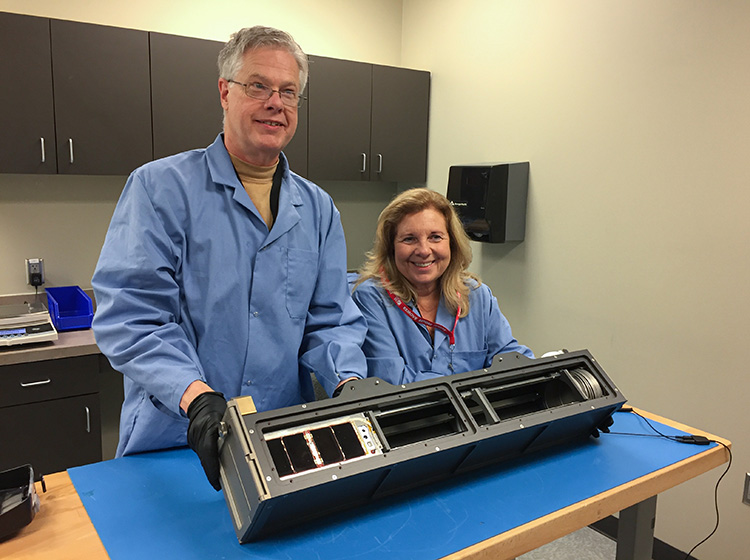
A dozen anxious students and professors huddled around a speaker in a small room in California, waiting for any sign of life. It was 11:21 p.m. on May 18, 2017, when years of hard work and cooperation with NASA’s Jet Propulsion Laboratory were realized.
A string of “beeps” cut the static, and the room erupted in applause: CSUNSat1 had survived a launch to space and was sending its first signal to the ground station at California State University, Northridge. Faculty members James Flynn (EE ’77) and Sharlene Katz—a potent husband-and-wife duo that led the project—calmly translated the dots and dashes of the satellite’s Morse code transmission. The message read “CSUNSAT1 A A A A A A.”
“We called this ‘straight A’s,’” Flynn says. “The message started by telling us the satellite was alive and in good health.”
Four years earlier, the team received a grant of $100,000 per year for two years from NASA and $60,000 from the Jet Propulsion Laboratory to support its part of the project, “Smallsat Low Mass, Extreme Low Temperature Energy Storage,” with JPL.
Project leads Flynn and Katz, both electrical and computer engineering faculty members at CSUN, wanted to build a satellite to test a battery developed by JPL that would withstand the bitterly cold temperatures of space, and NASA wanted to help.
“If you take batteries, little cells like those in vape pens, and they get too cold, they die permanently. [Spacecraft] need heaters for these, and they are all expensive, dangerous, and limit the mission,” Flynn says.

PHOTO: LEE CHO
Flynn, Katz, and a team of 70 students spent four years building a satellite that is the size of a shoebox to send to space to qualify JPL’s cold battery. CSUNSat1 was built with traditional and experimental energy cells to prove it could switch over and utilize the new technology. It worked, and the battery responded quickly to power needs—faster than NASA’s current cells. NASA plans to use the technology in future missions.
Despite years of planning and careful construction, failures on satellites such as CSUNSat1 were common, Flynn says, and the team was far from certain that the small box would make contact—let alone succeed in its primary mission of testing the new energy-storage system.
“Nothing is worse than knowing the satellite was coming over the horizon, but it is silent,” Flynn says.
Flynn served as a systems engineer on the project, making sure that the satellite came together perfectly. He focused on making sure that the satellite could talk to its ground station, making use of his background in communications.
After graduating from Illinois Institute of Technology, Flynn served as a consultant for the electronics used in the film, radio, and communications industry and ended up in California.
“Around then, I ran into a lovely lady from California State University, Northridge. She said I could tell a good story and encouraged me to start teaching in 2007. Long story short, we got married,” Flynn says of Katz.
After three years teaching, JPL reached out to the university. The lab asked faculty and students to build a satellite. It would provide guidance to the faculty and students before gradually leaving the project in the hands of those at CSUN.
“I was teaching young people about communications: FM, AM, TV, and so on,” Flynn says. “Now they say I have to learn how to talk with a satellite going 27 times the speed of sound, 200 miles up, and get all the information needed.”
CSUNSat1 was part of the CubeSat program, which NASA uses to test future technology by hitching the five-pound test craft to normal resupply and ferry rockets, usually those visiting the International Space Station. The university team watched live as astronauts released CSUNSat1 into low Earth orbit.
Flynn and Katz devoted themselves to the satellite while keeping a full teaching load, leading to long nights and early mornings.
JPL was interested in more than the satellite: it planned to use the project, and its 70 dedicated students, as a recruiting pipeline. It worked, and about 20 team members would go on to work at the nation’s premier spacecraft laboratory. Others would join SpaceX and similar space-focused companies.
Armen Arslanian, who was a second-year engineering student at CSUN at the time, joined the project and worked for nearly two years focused on the satellite’s communication. He went on to work at JPL.
“Both [Flynn and Katz] were educators,” Arslanian says. “They taught us industry standards and how things are done in the real world versus sitting in the classroom and learning about theoretical physics.”
Not long after the satellite completed its mission, Katz died of cancer late in 2017, and the satellite projects halted. Now, five years later, Flynn and the team at CSUN are ready for another satellite—this time, finding a cheap and simple solution to removing space debris.
“It was a lot of, ‘Oh no, here we go again,’” Flynn says. “Losing Dr. Katz took the wind out of our sail in more ways than one, but in her memory, I’ll try my darndest to get this mission up there.”

PHOTO: COURTESY OF JAMES FLYNN